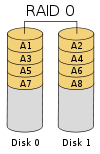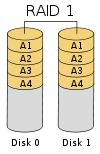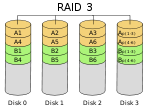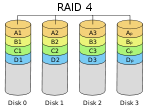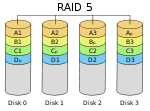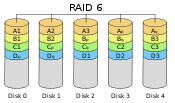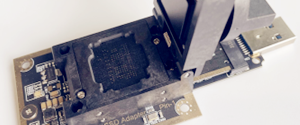RAID
RAID is the acronym of Redundant Array of Independent Disks. RAID is a performance enhancing method of storing the same data in different places on multiple hard disks. It is designed drive architecture developed to save critical data through redundancy. It is designed to offer high level of protection from data loss that can occur from any reasons like hardware failure, software corruption, or other malfunctioning.
RAID is just an arrangement of multiple disks designed to protect data after a disk injury. RAID array included in this technology can work for even thousands of years without loosing data due to disk failure. RAID is available in various levels of standards, which offer ranging degree of using multiple disks in reducing data loss. Benefits of RAID are:
* Reducing data loss
* Fault tolerance
* Improved input/output performance
* Storing large amount of data
* Handle much of the application requests, and many more.
More recently, marketers representing industry RAID manufacturers reinvented the term to describe a redundant array of independent disks as a means of disassociating a “low cost” expectation from RAID technology.
“RAID” is now used as an umbrella term for computer data storage schemes that can divide and replicate data among multiple hard disk drives. The different schemes/architectures are named by the word RAID followed by a number, as in RAID 0, RAID 1, etc. RAID’s various designs all involve two key design goals: increased data reliability or increased input/output performance. When multiple physical disks are set up to use RAID technology, they are said to be in a RAID array. This array distributes data across multiple disks, but the array is seen by the computer user and operating system as one single disk. RAID can be set up to serve several different purposes.
Following is a brief summary of the most commonly used RAID levels. Space efficiency is given as amount of storage space available in an array of n disks, in multiples of the capacity of a single drive. For example if an array holds n=5 drives of 250GB and efficiency is n-1 then available space is 4 times 250GB or roughly 1TB.
RAID 0
“Striped set without parity” or “Striping”. Provides improved performance and additional storage but no redundancy or fault tolerance. Any disk failure destroys the array, which has greater consequences with more disks in the array (at a minimum, catastrophic data loss is twice as severe compared to single drives without RAID). A single disk failure destroys the entire array because when data is written to a RAID 0 drive, the data is broken into fragments. The number of fragments is dictated by the number of disks in the array. The fragments are written to their respective disks simultaneously on the same sector. This allows smaller sections of the entire chunk of data to be read off the drive in parallel, increasing bandwidth. RAID 0 does not implement error checking so any error is unrecoverable. More disks in the array means higher bandwidth, but greater risk of data loss.
Minimum # of disks: 2
Space Efficiency: n
RAID 1
‘Mirrored set without parity’ or ‘Mirroring’. Provides fault tolerance from disk errors and failure of all but one of the drives. Increased read performance occurs when using a multi-threaded operating system that supports split seeks, as well as a very small performance reduction when writing. Array continues to operate so long as at least one drive is functioning. Using RAID 1 with a separate controller for each disk is sometimes called duplexing.
Minimum # of disks: 2
Space Efficiency: 1 (size of the smallest disk)
RAID 2
Hamming code parity. Disks are synchronized and striped in very small stripes, often in single bytes/words. Hamming codes error correction is calculated across corresponding bits on disks, and is stored on multiple parity disks.
Minimum # of disks: 3
Striped set with dedicated parity or bit interleaved parity or byte level parity.
This mechanism provides fault tolerance similar to RAID 5. However, because the strip across the disks is a lot smaller than a filesystem block, reads and writes to the array perform like a single drive with a high linear write performance. For this to work properly, the drives must have synchronised rotation. If one drive fails, the performance doesn’t change.
Minimum # of disks: 3
Space Efficiency: n-1
RAID 4
Block level parity. Identical to RAID 3, but does block-level striping instead of byte-level striping. In this setup, files can be distributed between multiple disks. Each disk operates independently which allows I/O requests to be performed in parallel, though data transfer speeds can suffer due to the type of parity. The error detection is achieved through dedicated parity and is stored in a separate, single disk unit.
Minimum # of disks: 3
Space Efficiency: n-1
Striped set with distributed parity or interleave parity. Distributed parity requires all drives but one to be present to operate; drive failure requires replacement, but the array is not destroyed by a single drive failure. Upon drive failure, any subsequent reads can be calculated from the distributed parity such that the drive failure is masked from the end user. The array will have data loss in the event of a second drive failure and is vulnerable until the data that was on the failed drive is rebuilt onto a replacement drive. A single drive failure in the set will result in reduced performance of the entire set until the failed drive has been replaced and rebuilt.
Minimum # of disks: 3
Space Efficiency: n-1
Striped set with dual distributed parity. Provides fault tolerance from two drive failures; array continues to operate with up to two failed drives. This makes larger RAID groups more practical, especially for high availability systems. This becomes increasingly important because large-capacity drives lengthen the time needed to recover from the failure of a single drive. Single parity RAID levels are vulnerable to data loss until the failed drive is rebuilt: the larger the drive, the longer the rebuild will take. Dual parity gives time to rebuild the array without the data being at risk if a (single) additional drive fails before the rebuild is complete.
Minimum # of disks: 4
Space Efficiency: n-2
Data recovery salon is dedicated in sharing the most useful data recovery information with our users and only if you are good at data recovery or related knowledge, please kindly drop us an email and we will publish your article here. We need to make data recovery Salon to be the most professional and free data recovery E-book online.
World’s Top Data Recovery Hardware Tools

Easy to use at good price
Recover SATA, IDE, External HDDs, NVME SSDs, etc Order Now here
POTABLE DEVICE & NVME SSD RECOVERY TOOL
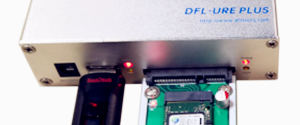
Recover USB Device and NVME SSDs at high speed! Read Details here.
DFL-PCIE DATA RECOVERY RECHARGE
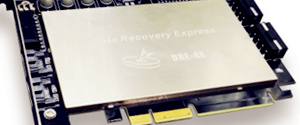
Best data recovery hardware tool to start a data recovery business, read details here
RECOVER SCRATCHED HDDS

Recover lost data from scratched hard drives, read details here.
SURFACE PRO. RECOVERY
BEST HEAD REPLACEMENT TOOLS
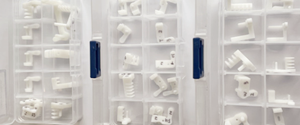
The most cost-effective head replacement tools for Seagate, WD, Samsung, Hitachi, Toshiba, Fujitsu

